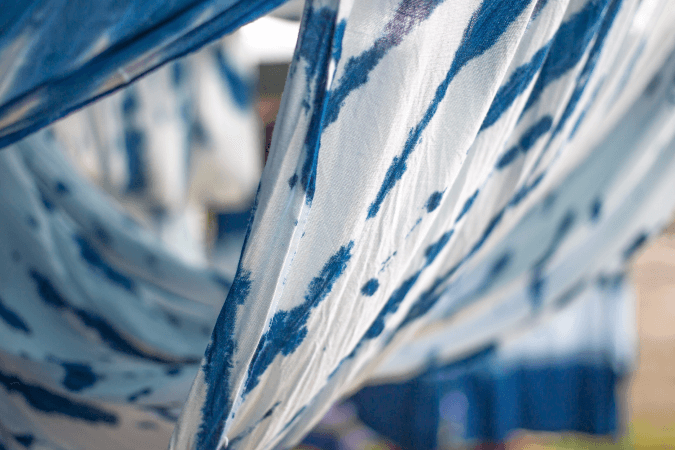TUTOR:
OK, Jim. You wanted to see me about your textile design project.
JIM:
That’s right. I’ve been looking at how a range of natural dyes can be used to colour fabrics like cotton and wool.
TUTOR:
Why did you choose that topic?
JIM:
Well, I got a lot of useful ideas from the museum, you know, at that exhibition of textiles. But I’ve always been interested in anything to do with colour. Years ago, I went to a carpet shop with my parents when we were on holiday in Turkey, and I remember all the amazing colours.
TUTOR:
They might not all have been natural dyes.
JIM:
Maybe not, but for the project I decided to follow it up. And I found a great book about a botanic garden in California that specialises in plants used for dyes.
TUTOR:
OK. So, in your project, you had to include a practical investigation.
JIM:
Yeah. At first I couldn’t decide on my variables. I was going to just look at one type of fibre for example, like cotton …
TUTOR:
… and see how different types of dyes affected it?
JIM:
Yes. Then I decided to include others as well, so I looked at cotton and wool and nylon.
TUTOR:
With just one type of dye
JIM:
Various types, including some that weren’t natural, for comparison.
JIM:
So, I did the experiments last week. I used some ready-made natural dyes. I found a website which supplied them, they came in just a few days, but I also made some of my own.
TUTOR:
That must have taken quite a bit of time.
JIM:
Yes, I’d thought it’d just be a matter of a teaspoon or so of dye, and actually that wasn’t the case at all. Like I was using one vegetable, beetroot, for a red dye, and I had to chop up a whole pile of it. So it all took longer than I’d expected.
TUTOR:
One possibility is to use food colourings.
JIM:
I did use one. That was a yellow dye, an artificial one.
JIM:
Yeah. I used it on cotton first. It came out a great colour, but when I rinsed the material, the colour just washed away. I’d been going to try it out on nylon, but I abandoned that idea.
TUTOR:
Were you worried about health issues?
JIM:
I’d thought if it’s a legal food colouring, it must be safe.
TUTOR:
Well, it can occasionally cause allergic reactions, I believe.
TUTOR:
So what natural dyes did you look at?
JIM:
Well, one was turmeric. The colour’s great, it’s a really strong yellow. It’s generally used in dishes like curry.
TUTOR:
It’s meant to be quite good for your health when eaten, but you might find it’s not permanent when it’s used as a dye – a few washes, and it’s gone.
JIM:
Right. I used beetroot as a dye for wool. When I chop up beetroot to eat I always end up with bright red hands, but the wool ended up just a sort of watery cream shade. Disappointing.
TUTOR:
There’s a natural dye called Tyrian purple. Have you heard of that?
JIM:
Yes. It comes from a shellfish, and it was worn in ancient times but only by important people as it was so rare. I didn’t use it.
TUTOR:
It fell out of use centuries ago, though one researcher managed to get hold of some recently. But that shade of purple can be produced by chemical dyes nowadays. Did you use any black dyes?
JIM:
Logwood. That was quite complicated. I had to prepare the fabric so the dye would take.
TUTOR:
I hope you were careful to wear gloves.
JIM:
Yes. I know the danger with that dye.
TUTOR:
Good. It can be extremely dangerous if it’s ingested. Now, presumably you had a look at an insect-based dye? Like cochineal, for example?
JIM:
Yes. I didn’t actually make that, I didn’t have time to start crushing up insects to get the red colour and anyway they’re not available here, but I managed to get the dye quite easily from a website. But it cost a fortune. I can see why it’s generally just used in cooking, and in small quantities.
TUTOR:
Yes, it’s very effective, but that’s precisely why it’s not used as a dye.
JIM:
I also read about using metal oxide. Apparently you can allow iron to rust while it’s in contact with the fabric, and that colours it.
TUTOR:
Yes, that works well for dying cotton. But you have to be careful as the metal can actually affect the fabric and so you can’t expect to get a lot of wear out of fabrics treated in this way. And the colours are quite subtle, not everyone likes them. Anyway, it looks as if you’ve done a lot of work …
 Sau khi nghe tutor hỏi " Why did you choose that topic?" biết đáp án chuẩn bị vào
Sau khi nghe tutor hỏi " Why did you choose that topic?" biết đáp án chuẩn bị vào Đầu tiên Jim có nhắc tới exhibition of textiles, nhiều bạn sẽ chọn đáp án A
Đầu tiên Jim có nhắc tới exhibition of textiles, nhiều bạn sẽ chọn đáp án A  Jim nói tiếp rằng mình luôn quan tâm đến màu sắc, và có đề cập tới carpet show when we were on holiday
Jim nói tiếp rằng mình luôn quan tâm đến màu sắc, và có đề cập tới carpet show when we were on holiday 

